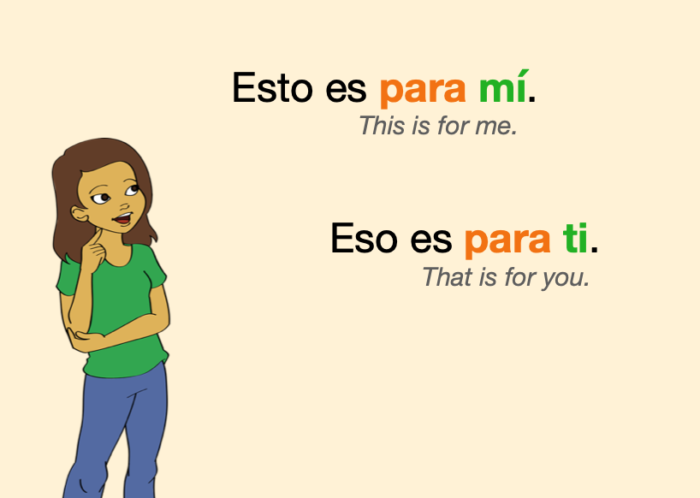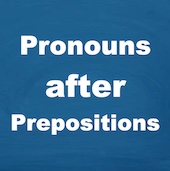Welcome 😊 to our grammar lesson on Spanish pronouns after prepositions (also known as prepositional pronouns).
Here we will learn the pronouns we can place after the different prepositions in Spanish.

In order to explain this, we will divide prepositions into 2 groups. Then we will study the preposition con separately.
You will also find a Quiz and an Exercise to practice.
Group 1
After any preposition on the left side of this table, we are allowed to use the pronouns on the right side:
| Prepositions | Personal Pronouns |
|---|---|
| a (to...) ante (in the face of) contra (against) de (of, from) desde (from) en (in, at...) hacia (towards) para (for...) por (for...) sin (without) sobre (above, on) hasta (except when it means "even") | mí |
| ti | |
| él ella usted sí (reflexive*) |
|
| nosotros nosotras |
|
| vosotros vosotras |
|
| ellos ellas ustedes sí (reflexive*) |
Examples:
A mí me gusta bailar.
I like to dance.Estas palabras vienen de él.
These words come from him.El libro es para ti.
The book is for you.La noticia llega hasta nosotros.
The news comes to us.
* The pronoun sí (which appears twice on the table above) can be used instead of “él, ella, usted, ellos, ellas, ustedes” when the action is reflexive. It’s usually followed by mismo/misma/mismos/mismas:
El hombre habla sobre sí mismo.
The man talks about himself.Ellos juegan contra sí mismos.
They play against themselves.
Group 2
After any preposition on the left side of the this table, we use yo and tú instead of “mí” and “ti”. Apart from that, the rest of the pronouns are the same as for Group 1:
| Prepositions | Personal Pronouns |
|---|---|
| entre (between) excepto (except) incluso (even) menos (except) salvo (except) según (according to) hasta (only when it means "even") | yo |
| tú | |
| él ella usted |
|
| nosotros nosotras |
|
| vosotros vosotras |
|
| ellos ellas ustedes |
Examples:
Esto queda entre tú y yo.
This stays between you and me.Hasta yo lo sé.
Even I know it.Según ellos, no va a pasar nada.
According to them, nothing’s gonna happen.Todo el mundo va a la fiesta excepto vosotros.
Everybody’s going to the party except for you guys.
The preposition “con”
In the case of con (with), for the first two persons we use conmigo and contigo, written in one word:
| conmigo |
| contigo |
| con él con ella con usted consigo (reflexive**) |
| con nosotros con nosotras |
| con vosotros con vosotras |
| con ellos con ellas con ustedes consigo (reflexive**) |
Examples:
Ven conmigo.
Come with me.Contigo soy feliz.
With you, I’m happy.María tiene una relación con él.
María has a relationship with him.
** The form consigo can be used instead of “con él, con ella, con usted, con ellos, con ellas, con ustedes” when the action is reflexive. It’s usually followed by mismo/misma/mismos/mismas:
El hombre habla consigo mismo.
The man talks to himself.Ellas están enfadadas consigo mismas.
They are angry with themselves.
Practice
Quiz
Take this short Quiz about personal pronouns after prepositions:
Exercise 1
Fill the gaps using personal pronouns. Click on the gray spaces to see the solutions:
1) El regalo es para ella .
The gift is for her.2) Yo voy contigo .
I go with you.3) El perro está entre ella y yo .
The dog is between her and me.4) Todos están invitados, menos tú .
Everybody is invited, except you.
Exercise 2
More sentences!:
5) Te necesito a ti .
I need you.6) Organizamos una fiesta para vosotros .
We organize a party for you guys.7) La mujer está satisfecha consigo misma.
The woman is satisfied with herself.8) El gato corre hacia mí .
The cat runs towards me.









